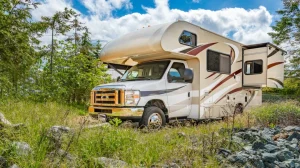The lights flicker and go out. In that moment of sudden silence and darkness, your first questions are likely: “Is it just my house?” “How widespread is this?” and “When will the power be back on?”During a power outage, information is power. The most effective tool is the CenterPoint outage map, which shows status and estimated restoration times across the service area.
Quick preparedness note: While the CenterPoint outage map gives you real-time visibility, consider a basic backup plan so you’re not fully dependent on the grid. A compact portable power station paired with a lightweight, high-efficiency solar panel keeps phones, a Wi-Fi router, medical essentials, and lights running during daylight hours. For tight spaces or curved surfaces (balconies, RV roofs, boats), Sungold’s custom non-standard PV modules can be built to fit and maintain output under partial shade.
How Do I Find the CenterPoint Outage Map Quickly?
In an emergency, you need information immediately. Here are the fastest ways to access the CenterPoint Energy Outage Map, even from your mobile device.
Direct Link: The quickest way is to go directly to the official map.
Bookmark this link now for future use: CenterPoint Energy Outage Tracker
Google Search: Open your phone’s browser and search for terms like:
“CenterPoint outage map”
“CenterPoint power outage”
“Houston power outage map”
The official link will almost always be the top result.
From the Homepage: Navigate to the CenterPoint Energy homepage. You will typically find a prominent link for “Outage Center” or a banner during major weather events.
Pro-Tip: Since you’ll likely be on a mobile device during an outage, bookmark the link on your phone’s home screen for one-tap access.
How to Read & Navigate the CenterPoint Energy Outage Map
The outage map provides a wealth of information at a glance. Here’s how to navigate it step-by-step.
(Suggested Image: A screenshot of the CenterPoint Outage Map with key areas like the search bar and legend highlighted.)
Step 1: Enter Your Location
Use the search bar at the top of the map to enter your full address. This will zoom the map directly to your location, allowing you to see if there is a reported outage icon near your home or business.
Step 2: Understand the Icons & Colors
The map uses a simple color-coded system to show the scale of an outage.
Green/Blue Icons: Typically indicate a smaller number of affected customers (e.g., 1–50).
Yellow/Orange Icons: Represent a larger outage (e.g., 51–500 customers).
Red Icons: Signal a major outage affecting a large number of customers (e.g., 501+).
Step 3: Click for Detailed Information
Tap or click on any outage icon near you. A pop-up window will appear with specific details about that outage event. This is where you’ll find the most critical information.
What the CenterPoint Outage Tracker Icons & Statuses Mean
When you click on an outage icon, you’ll see several key pieces of information. Here’s what they mean for you:
Status: This tells you the current stage of the repair process.
Pending / Outage Reported: The outage has been logged in the system but a crew has not yet been assigned.
Crew Dispatched / En Route: A team is on its way to investigate and begin repairs. This is a positive sign.
Crew on Site: The team has arrived. They are assessing the damage and determining the safest way to restore power.
Restoration in Progress: Repairs are actively underway.
ETR (Estimated Time of Restoration): This is the time CenterPoint expects to have power restored. Important: This is an estimate. It can change based on the complexity of the damage found on-site. Check back periodically for updates.
Customers Affected: This number shows how many homes and businesses are part of the same outage event. If the number is large, it could indicate a more significant issue that may take longer to resolve.
What to Do If Your CenterPoint Outage Isn’t on the Map
What if your power is out but you don’t see an outage icon over your address? Don’t worry; this is common. Here is the process to follow.
First, Check Your Breakers: Before reporting, go to your electrical panel and check if any breakers have tripped. If a single breaker is flipped, reset it. If the main breaker is tripped, there could be a larger issue with your home’s system.
If It’s Not Your Breakers, Report the Outage: CenterPoint may not know about your specific outage yet, especially if it’s localized. Reporting it is crucial.
Online: Use the official reporting tool online. You’ll need your address or account number.
By Phone: Call CenterPoint Energy’s outage line at 713-207-2222 or 800-332-7143. Be prepared for potential wait times during major storms.
Once you report it, your outage should appear on the map, often as a single-customer outage icon, until it is merged with a larger event.
Bridge the gap while you wait: Reporting your outage helps crews prioritize, but restoration can still take time. A small solar + portable battery kit can bridge critical needs (charging, communications, LED lighting). If you have unusual dimensions or mounting constraints, Sungold can manufacture non-standard modules to your target size and voltage, with back-exit cabling for clean installs.

How to Prepare for Future CenterPoint Outages
The best time to deal with a power outage is before it happens. Regain a sense of control by taking these proactive steps.
Sign Up for Alerts: Register for CenterPoint’s Power Alert Service. They will send you text, email, or phone call updates specific to your address, including when an outage is reported and when restoration is expected.
Build an Emergency Kit: Assemble a kit with essentials like:
Flashlights and fresh batteries
A battery-powered or hand-crank radio
Bottled water (one gallon per person, per day)
Non-perishable food and a manual can opener
A first-aid kit
Invest in Backup Power: For ultimate peace of mind, consider a backup power solution. A portable power station can be a lifesaver, allowing you to keep your refrigerator cold, phones charged, medical devices running, and some lights on. It’s a quiet, fume-free alternative to traditional generators.
CenterPoint Outage Map FAQ
Q: How often is the CenterPoint outage map updated?
A: The map is updated approximately every 5 to 15 minutes, providing near real-time information as it becomes available from field crews and the control center.
Q: Can I see the cause of the outage on the map?
A: Sometimes. In the detail pop-up, CenterPoint may list a cause, such as “Weather,” “Equipment Failure,” or “Vehicle Accident.” If the cause is still under investigation, it may be listed as “Pending Assessment.”
Q: What should I do if I see a downed power line?
A: Stay far away. Always assume a downed power line is live and dangerous. Do not touch it or anything it is in contact with. Immediately call 911 and then report it to CenterPoint at 713-207-2222.
Q: Can solar panels power my entire home during an outage?
A: Not by themselves. Portable systems are great for essentials (communications, lighting, small devices). To safely power home circuits, you’ll need an appropriate inverter, a transfer switch, and code-compliant wiring by a licensed electrician.
Q: I live in an apartment—can I still use solar during outages?
A: Yes, for essentials. Lightweight, custom-sized modules (e.g., balcony-friendly) can feed a portable power station during the day. Always follow building rules and avoid any permanent electrical tie-ins to the dwelling circuits.
Q: My space is curved or narrow. Are there panels that fit?
A: Sungold manufactures non-standard PV modules to target dimensions and voltage, with shade-tolerant stringing and back-exit cabling—useful for RV roofs, boats, or tight balcony rails.







